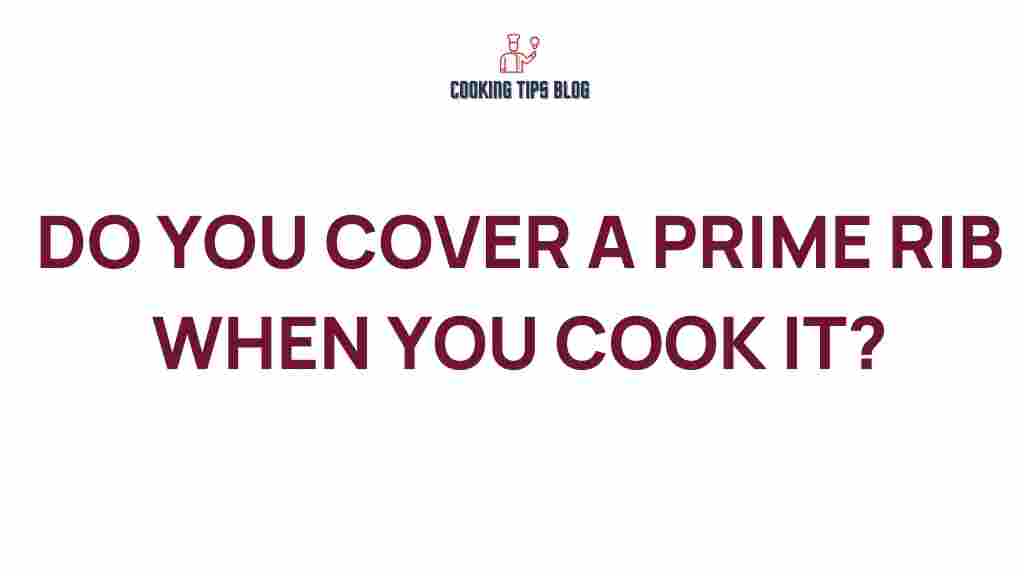The Surprising Truth: Should You Cover Prime Rib While Cooking?
Prime rib is a classic dish that many home cooks aspire to perfect. Known for its rich flavor and tender texture, it can elevate any dinner party or holiday gathering. However, one of the most debated topics among culinary enthusiasts is whether or not to cover prime rib while cooking. This article will explore the surprising truth behind this question, offering insights on how to achieve the best results with your prime rib.
Understanding Prime Rib
Before diving into the cooking techniques, it’s essential to understand what prime rib is. Prime rib is a cut of beef from the primal rib section of the cow. It’s well-marbled, which contributes to its flavor and tenderness. When cooked correctly, prime rib can be one of the most delicious and satisfying meals you’ll ever prepare.
Here are a few key points about prime rib:
- Marbling: The intramuscular fat in prime rib enhances its flavor and keeps it moist during cooking.
- Cooking Methods: Prime rib can be roasted, smoked, or grilled, each method offering a unique flavor profile.
- Doneness Levels: Many prefer prime rib medium-rare, which allows the natural juices to shine.
Should You Cover Prime Rib While Cooking?
Now, let’s address the question at hand: should you cover prime rib while cooking? The answer isn’t straightforward, as it depends on the cooking method and desired outcome. Here are several factors to consider:
1. Cooking Method
The method you choose for cooking your prime rib significantly influences whether you should cover it. Here are the main methods:
- Oven Roasting: When roasting prime rib in the oven, many chefs recommend leaving it uncovered. This allows the exterior to develop a beautiful crust while the inside remains tender.
- Smoking: If you’re smoking your prime rib, it’s best to keep it uncovered to let the smoke penetrate the meat, enhancing its flavor.
- Wrapping in Foil: Some home cooks opt to cover it with foil during the initial stages of cooking to retain moisture, particularly if they’re worried about overcooking.
2. Desired Crust
Covering prime rib can prevent the formation of a crust. If you prefer a well-browned exterior, it’s advisable to cook it uncovered. The Maillard reaction, which gives meat its rich color and flavor, occurs at higher temperatures, and covering it can trap steam, leading to a softer, less appealing crust.
3. Resting Period
After cooking, letting the prime rib rest is crucial. During this time, covering it loosely with foil can help retain heat without steaming it, maintaining the quality of the crust.
Step-by-Step Process for Cooking Prime Rib
Here’s a simple step-by-step guide to cooking prime rib, taking into consideration the points discussed:
Step 1: Choose Your Cut
Select a quality prime rib cut from a reputable butcher. Look for good marbling and a nice fat cap, which will help keep the meat moist during cooking.
Step 2: Prepare the Meat
Allow the prime rib to come to room temperature before cooking. This ensures even cooking throughout the roast.
Step 3: Season Generously
Season your prime rib generously with salt, pepper, and any other herbs or spices you prefer. A simple mixture of garlic powder and rosemary works wonderfully.
Step 4: Preheat the Oven
Preheat your oven to 450°F (232°C). This initial high temperature will help create a crust.
Step 5: Roast the Prime Rib
Place the prime rib in a roasting pan, bone-side down. Roast uncovered for about 15-20 minutes for a nice sear, then reduce the oven temperature to 325°F (163°C) and continue cooking until it reaches your desired doneness:
- Rare: 120°F (49°C)
- Medium Rare: 130°F (54°C)
- Medium: 140°F (60°C)
- Medium Well: 150°F (66°C)
- Well Done: 160°F (71°C)
Step 6: Check the Temperature
Use a meat thermometer to check the internal temperature. Insert it into the thickest part of the meat, avoiding the bone.
Step 7: Rest the Meat
Once cooked, remove the prime rib from the oven and let it rest for at least 20-30 minutes. Cover it loosely with foil to keep it warm without steaming.
Troubleshooting Tips for Cooking Prime Rib
Cooking prime rib can be intimidating, especially if it’s your first time. Here are some common issues and how to address them:
Problem: Overcooked Prime Rib
If your prime rib turns out overcooked, it could be due to leaving it in the oven for too long or cooking at too high of a temperature. To avoid this:
- Always use a meat thermometer to monitor the internal temperature.
- Consider using an oven-safe probe thermometer that alerts you when the meat reaches your desired doneness.
Problem: Lack of Flavor
If your prime rib lacks flavor, it may not have been adequately seasoned or marinated. To enhance flavor next time:
- Season generously with salt and let it sit for a few hours or overnight.
- Consider marinating the meat in a mixture of herbs, garlic, and olive oil.
Problem: Dry Prime Rib
A dry prime rib can result from overcooking or not allowing it to rest. To improve moisture:
- Cook the meat to the correct internal temperature and let it rest before slicing.
- Use a meat thermometer to ensure accuracy.
Conclusion
The question of whether to cover prime rib while cooking has no one-size-fits-all answer. It ultimately depends on your cooking method and desired outcome. For the best results, consider roasting your prime rib uncovered for a delicious crust while allowing it to rest covered to maintain warmth. With careful preparation and attention to detail, you can create a prime rib that will impress your guests and leave them asking for seconds.
For more information on cooking techniques and recipes, feel free to check out this comprehensive guide. And if you’re looking to learn more about different cuts of beef, visit this resource for an in-depth look.
This article is in the category Tools and created by Cookingtipsblog Team
